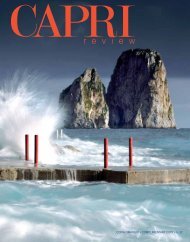COPIA OMAGGIO ⢠COMPLIMENTARY COPY EDIZIONI PRC
COPIA OMAGGIO ⢠COMPLIMENTARY COPY EDIZIONI PRC
COPIA OMAGGIO ⢠COMPLIMENTARY COPY EDIZIONI PRC
Create successful ePaper yourself
Turn your PDF publications into a flip-book with our unique Google optimized e-Paper software.
[Luoghi]<br />
Scandal on Capri<br />
Legend has it - and Capri’s legends always have a grain of truth<br />
about them - that one day Kaiser Wilhelm sent a pistol to his loyal<br />
subject and friend, Friedrich Alfred, along with a vaguely sinister<br />
note the ruler had penned himself: “You know how to use it”. Just<br />
a few days later, on 22 November 1902, Krupp did use it. Against<br />
himself. Norman Douglas, a most refined writer who often sang<br />
Capri’s praises, offered this comment: “It was a homicide, not a<br />
suicide”.<br />
He was thinking of the sensationalistic press campaign that<br />
had been aimed at the “king of cannons” for months, dragging<br />
in other well-known members of the German nobility who<br />
sojourned on Capri as well. A newspaper of socialist inspiration,<br />
La Propaganda, had led off with a short article whose title was<br />
unequivocal: “Capri - Sodom”. It wasn’t long before the official<br />
party organ, l’Avanti!, joined in, as well as Vorwarts, the German<br />
socialist newspaper. Orgies, risqué parties, and reckless<br />
homosexual encounters were rumoured to have taken place in<br />
the dark recesses of the Grotto of Fra’ Felice, along Via Krupp.<br />
Much later - and all too late, alas - these stories were shown<br />
to be grossly exaggerated or even outright lies: a set-up, in<br />
any case; a chapter in the annals of the local power struggles<br />
between the mayor in office, the Catholic Serena, a good friend<br />
of Krupp’s, who would end up the victim of the scheme, and the<br />
Morgano family in the ascendant, whose credo was socialism.<br />
The ‘damning evidence’ was an electoral dossier fabricated by<br />
a professor who was peeved with the German industrialist over<br />
his decision to study Italian with another teacher.<br />
Thus ended a brief season of genius, eccentricity, and art. And<br />
a legend was born.<br />
M. MASTRORILLO<br />
costruzione - che peraltro durò appena<br />
due anni - perché la si percorre senza<br />
eccessiva fatica anche in salita. Roberto<br />
Pane, nella sua “Guida di Capri”, la<br />
definisce un’opera d’arte, e ha ragione<br />
perché essa appartiene più alla scultura<br />
che all’edilizia.<br />
Perché quella strada? C’è una risposta<br />
ovvia e minimalista: per arrivare rapidamente<br />
a Marina Piccola. Ce n’è un’altra,<br />
come dire?, imprenditoriale: Krupp<br />
voleva dare lavoro ai capresi e indicare<br />
loro il futuro dell’isola, lo sviluppo del<br />
turismo. A me piace immaginare, invece,<br />
Lunga 1.346 metri,<br />
via Krupp<br />
ha tornanti a 90°.<br />
Via Krupp has hairpin<br />
bonds<br />
and stretches<br />
for 1,346 m.<br />
che avesse pensato al suo sentiero come a<br />
una discesa verso il mare, simile alle tante<br />
che dalle sue navi faceva verso il blu delle<br />
acque intorno all’isola. Del resto, prima<br />
di cominciare la discesa viene spontaneo<br />
guardare verso le trasparenze del mare,<br />
e quando si è arrivati giù viene voglia di<br />
volgere lo sguardo all’insù. Come si fa<br />
quando ci si immerge sotto lo scoglio del<br />
Monacone o nella Grotta Azzurra.<br />
Dopo l’inaugurazione della sua via, Friederich<br />
Alfred Krupp vivrà solo due anni ancora.<br />
L’ultima immersione sarà nel buio della<br />
ragione, nelle tenebre della tragedia. <br />
the tenacity and the supreme effort of building<br />
it - which took under two years - so that the<br />
uphill climb would not be too monstrously<br />
difficult. In his Guide to Capri, Roberto Pane<br />
calls Via Krupp a work of art, and rightly<br />
so: the road is more of a sculpture than a<br />
construction project.<br />
Why build that road at all, however? The<br />
obvious if reductive answer is: to get to<br />
the Marina Piccola faster. There’s another<br />
answer, though, which you might say is of<br />
an ‘entrepreneurial’ nature: Krupp wanted<br />
to provide the inhabitants of Capri with<br />
employment and point them in the direction of<br />
the island’s future: tourism. I myself choose<br />
to believe, instead, that Krupp had designed<br />
his path as a descent to the sea, not unlike<br />
the many diving expeditions he made from his<br />
boats himself, dropping deeper and deeper<br />
into the blue waters around the island. After<br />
all, when you set out down Via Krupp, you do<br />
glance spontaneously over at the surface of the<br />
sea below before you start the descent; and<br />
when you reach the bottom you are seized with<br />
an irresistible urge to look back up to the top.<br />
Which is exactly what happens when you dive<br />
under the rock face at Monacone or beneath<br />
the waters of the Blue Grotto.<br />
After the inauguration of his road, Friedrich<br />
Alfred Krupp lived on only two more years.<br />
His last descent would be into folly, into the<br />
human soul’s most tragic depths. <br />
22



